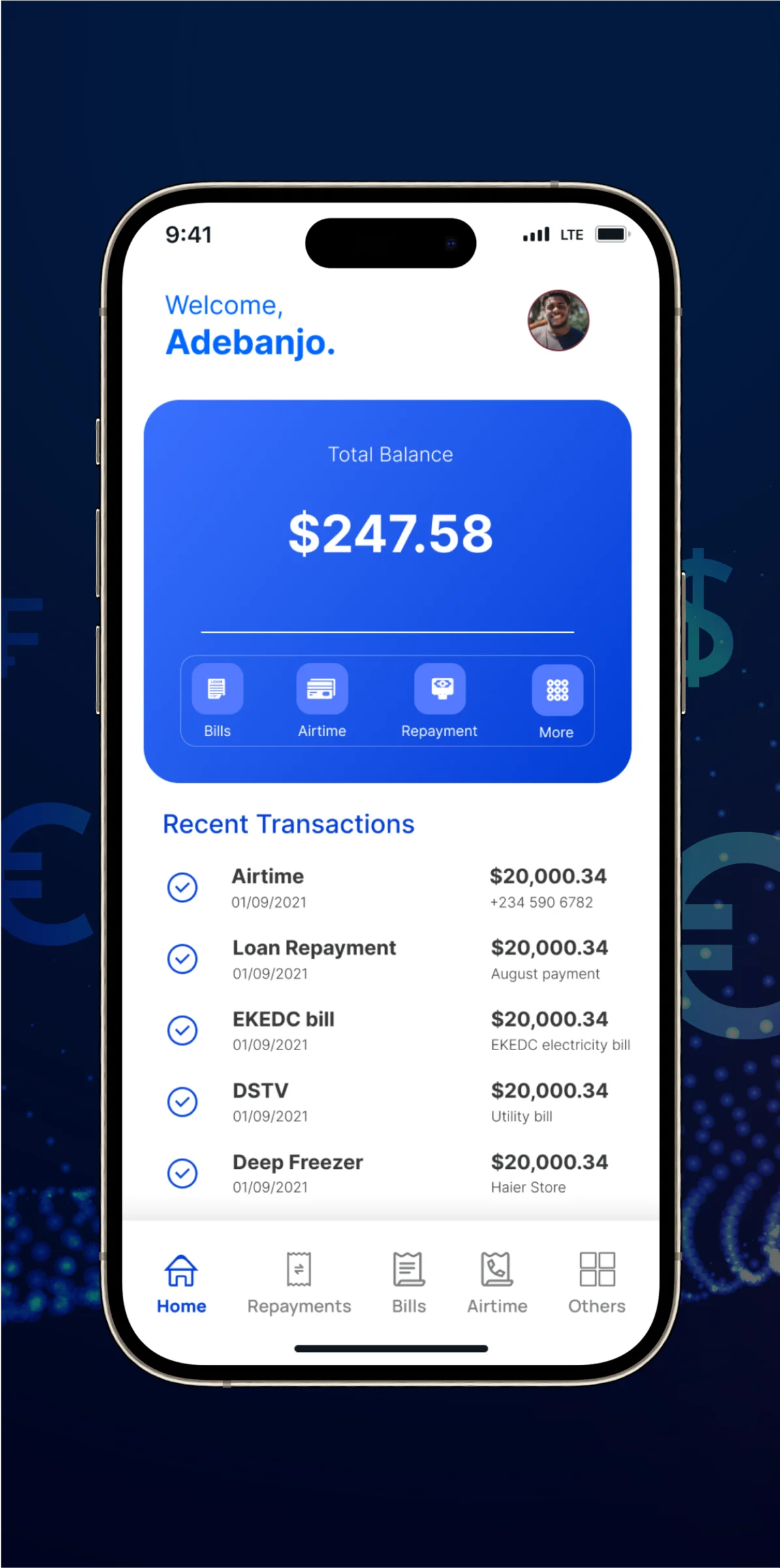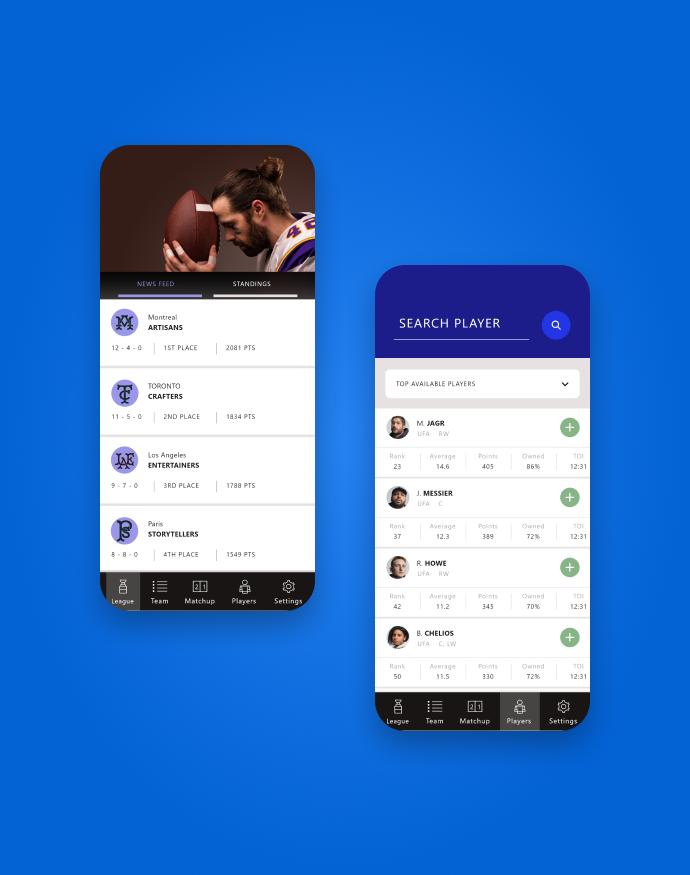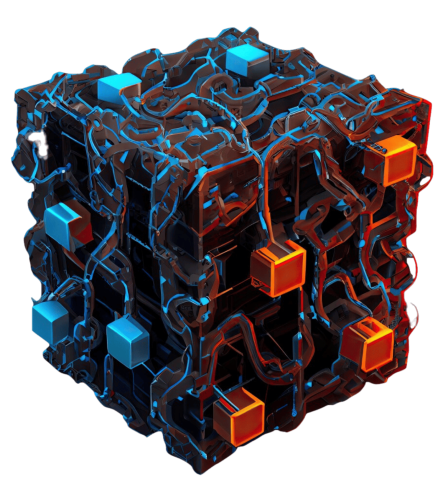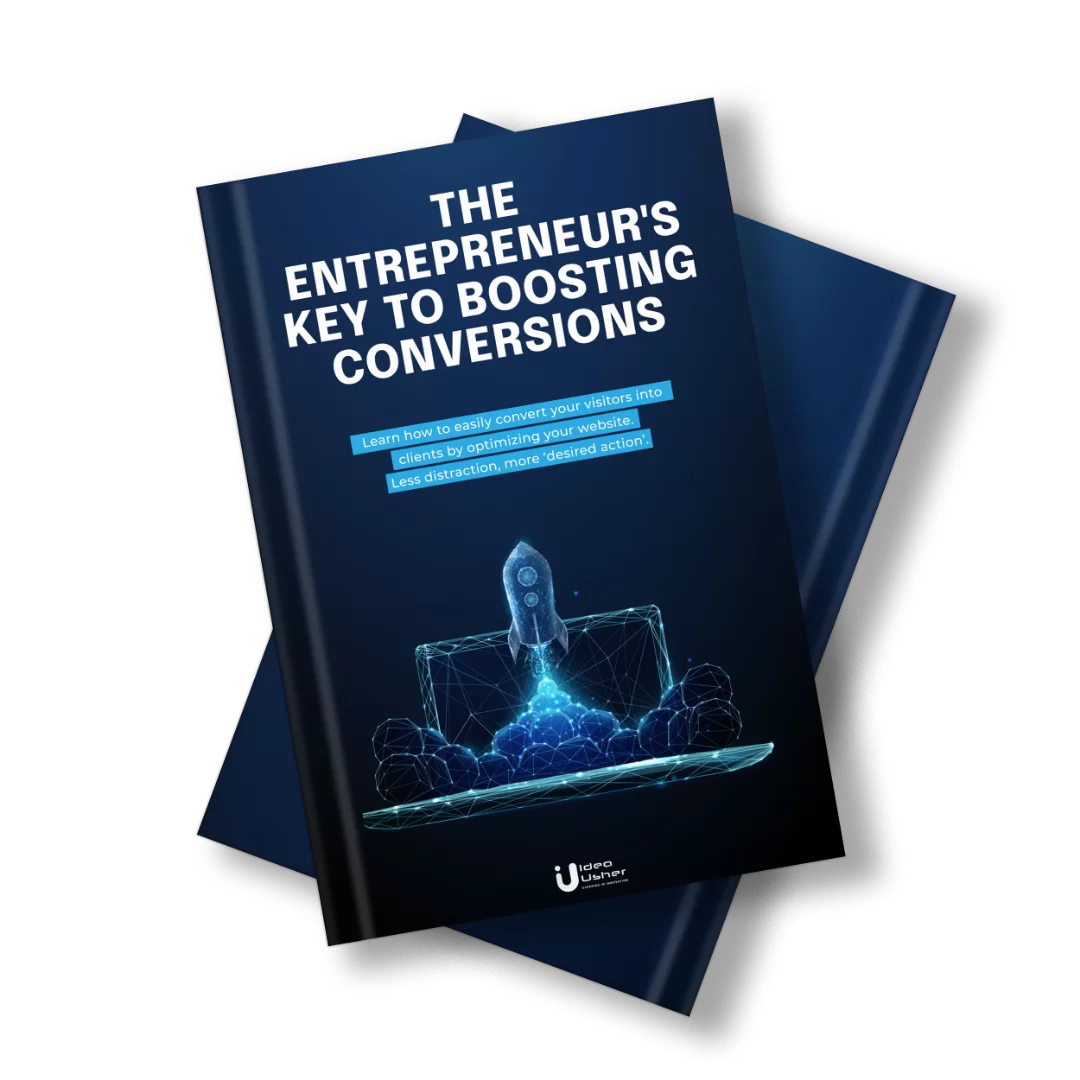- Key Market Takeaways for Blockchain Technology
- Fundamentals of Blockchain Development
- Different Types of Blockchain Technology for Enterprises
- Technical Skills Required for Blockchain Development
- Consensus Algorithms Required for Blockchain Development
- Benefits of Developing Blockchain Solution
- Some Important Tools Required For Blockchain Development
- How to Implement Blockchain Solutions in a Business From Scratch?
- Best Blockchain Platforms for Blockchain Development
- Top 5 Case Studies for Blockchain Solutions Integrated by Businesses
- Conclusion
- Looking to Develop a Blockchain Solution?
- FAQs
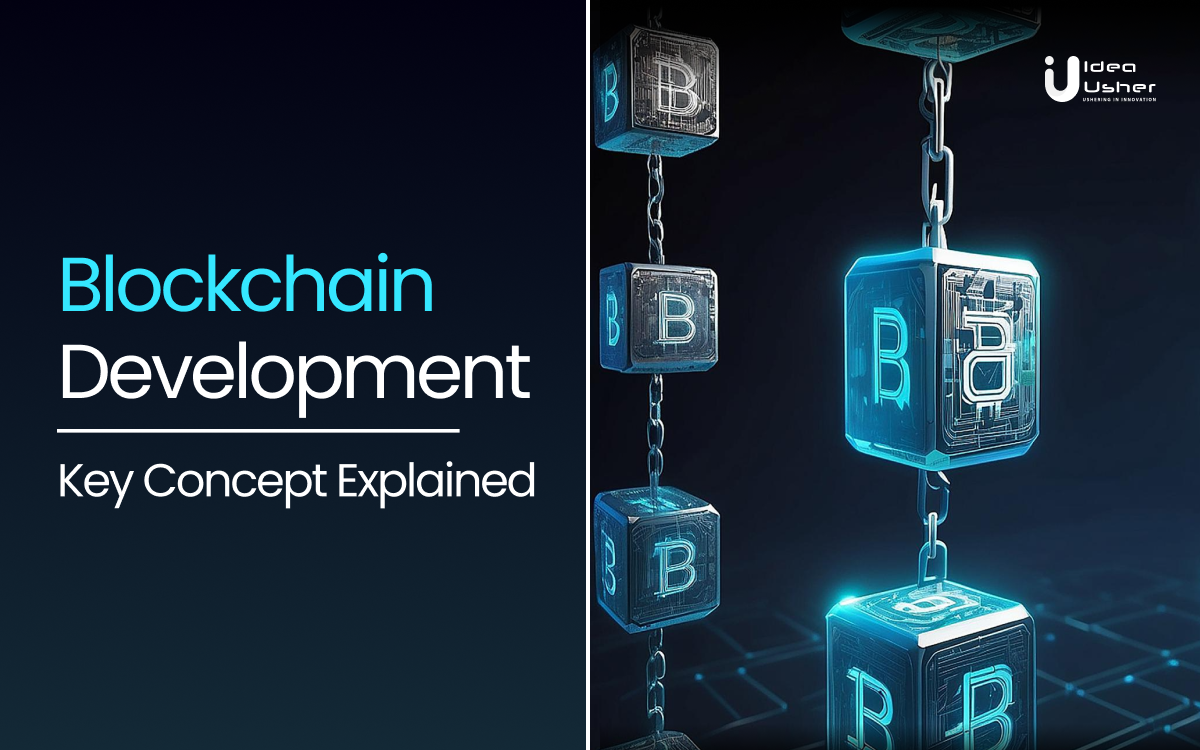
Blockchain technology has been making waves in the business world, with major companies like Amazon, IBM, and Walmart already integrating it into their operations. But what exactly are the key concepts of blockchain development, and why should businesses care?
Blockchain technology disrupts traditional record-keeping by offering a secure and transparent digital ledger. This decentralized network verifies and records transactions, providing businesses with a perfect tool to store and transfer data with enhanced security and transparency.
With its advanced cryptography and distributed database, blockchain offers secure and tamper-proof data storage, real-time transaction processing, and improved efficiency. With recent news of major companies adopting blockchain, it’s clear that this technology is not just a buzzword but a game-changing tool that businesses cannot afford to ignore. In this blog, we’re going to discuss all the key concepts of blockchain development and how it can benefit your business.
What is Blockchain Development?
Blockchain development refers to the process of creating applications and systems that utilize the unique features of blockchain technology. It basically works as a digital ledger that can be utilized to record transactions of any digital asset in a secure, transparent, and immutable manner. This cutting-edge technology uses a chain of blocks, each with a timestamp and a link to the previous block, making it impossible for any alterations or deletions to take place. With blockchain, data is kept secure and immutable, guaranteeing its authenticity and reliability.
For businesses, blockchain development can offer several benefits, such as streamlining operations by automating tasks and reducing errors, enhancing security by creating a tamper-proof record of transactions, and improving transparency by providing all authorized participants with a single view of the data. All this can help them increase their efficiency and build trust with their customers.
- Key Market Takeaways for Blockchain Technology
- Fundamentals of Blockchain Development
- Different Types of Blockchain Technology for Enterprises
- Technical Skills Required for Blockchain Development
- Consensus Algorithms Required for Blockchain Development
- Benefits of Developing Blockchain Solution
- Some Important Tools Required For Blockchain Development
- How to Implement Blockchain Solutions in a Business From Scratch?
- Best Blockchain Platforms for Blockchain Development
- Top 5 Case Studies for Blockchain Solutions Integrated by Businesses
- Conclusion
- Looking to Develop a Blockchain Solution?
- FAQs
Key Market Takeaways for Blockchain Technology
According to FortuneBusinessInsight, the global blockchain technology market is experiencing an explosive growth, with a projected value of $825.93 billion by 2032, compared to $1757 billion in 2023. This surge is primarily driven by the financial services industry (BFSI) embracing blockchain’s secure and transparent nature.
Source: FortuneBusinessInsight
BFSI companies have started using blockchain technology for tasks such as cross-border transactions, trade finance, and digital identity verification. Although concerns about scalability and sustainability persist, blockchain’s capacity to ensure data confidentiality, integrity, and availability puts it in a position for further development.
Key market players are jumping on this trend. For example, Amazon Web Services launched their Managed Blockchain Service in August 2022. This service supports popular open-source frameworks like Ethereum and Hyperledger Fabric, offering businesses a wider range of secure and customizable blockchain solutions. Additionally, Intel Corporation unveiled its latest Intel Blockscale ASIC technology in April 2022. This innovation provides energy-efficient blockchain hashing, a critical component for securing transactions within certain blockchain networks.
Fundamentals of Blockchain Development
First, let us start with some basic concepts you need to know about blockchain,
1. Decentralized System
Blockchain technology, in its simplest form, serves as a digital ledger system that links together blocks of records. What sets this technology apart from traditional databases is its decentralized nature, where information is not stored in a single central location. Instead, it is dispersed among a network of computers, also known as nodes. This decentralized structure reduces the need for a central authority, promoting transparency and security.
Each block within the blockchain consists of essential data, including transaction details, and is accompanied by a unique code known as a hash. This hash is generated by an intricate mathematical algorithm, making it virtually impossible for the data to be altered without detection. Moreover, the hash value of each block, which is linked to the previous block, creates a chain that guarantees the integrity of the information.
2. Decentralized Consensus
In a distributed network, critical decisions are determined through the use of consensus mechanisms. These mechanisms enable members to collaboratively come to an agreement on transactions and additions to the blockchain. This ensures the reliability and authenticity of data on the blockchain, even without a central governing authority.
There are various consensus algorithms implemented in blockchain technology, including Proof-of-Work and Proof-of-Stake. Each algorithm utilizes distinct approaches to verify transactions, all with the ultimate goal of safeguarding the integrity and security of the blockchain.
3. Smart Contracts
Smart contracts are a thrilling element of blockchain technology, offering numerous benefits in various industries. These programmable contracts are triggered automatically once specific conditions are met, storing all information on the blockchain. With transparency and no requirement for intermediaries, smart contracts save time and resources and mitigate the risk of mistakes and fraud. Businesses in sectors such as supply chain management, insurance, and real estate can take advantage of this feature resulting in smoother operations, improved productivity, and decreased expenses.
4. Mining
The process of verifying or incorporating transactions into the blockchain is referred to as mining. Miners utilize advanced computers to solve intricate mathematical problems and generate a unique code for every block. After the puzzle is solved, the block is then appended to the blockchain, and the miner receives a digital currency reward.
Mining is a pivotal aspect in upholding the safety and authenticity of the blockchain system. It guarantees that only legitimate transactions are included in the blockchain and deters any potential assaults on the network.
Different Types of Blockchain Technology for Enterprises
Here are some important categories of blockchain technologies you should know about,
1. Private Blockchain
A private Blockchain is a specific kind of digital ledger that is exclusively used by a single organization, giving them complete control over who has access to the network. Unlike public blockchains, which are open to everyone, private blockchains require authorization for entry. This additional layer of security makes sure that confidential information stays within the organization’s boundaries.
One of the main characteristics of private blockchains is the varying levels of access granted to different nodes. This enables smoother operations as read and write permissions can be customized based on specific roles and responsibilities.
Furthermore, private blockchains are known for their faster transaction processing, making them highly suitable for businesses that prioritize speedy and efficient transactions.
It’s worth noting, however, that private blockchains do not offer anonymity since all activity is visible to authorized parties. Despite this, they are a more cost-effective option compared to public blockchains, making them a lucrative choice for organizations looking to streamline their expenses.
2. Public Blockchain
Public Blockchain is a revolutionary form of distributed ledger technology that offers numerous advantages for businesses. Its fully decentralized structure ensures equal access for all network users, making it a transparent and highly secure platform.
Unlike private or permissioned Blockchains, public Blockchains allow any individual to join and contribute to the network, providing a greater sense of freedom and control for users.
Additionally, the inherent anonymity of public Blockchains ensures enhanced protection and security for businesses. By leveraging this technology, companies can achieve unparalleled transparency, as all transactions are recorded and permanently stored, eliminating the possibility of tampering or alterations.
3. Federated Blockchain
Federated blockchain technology has revolutionized the way multiple organizations can work together. This decentralized network allows for collaboration while maintaining the privacy of each organization involved. It is especially advantageous for enterprise companies due to its scalability, efficiency, and speed. With federated blockchain, these companies can securely authorize access to the network and benefit from faster output without compromising data privacy. In short, it is the perfect solution for businesses looking to leverage blockchain technology.
What sets federated blockchain apart is its distributed authority. This means that multiple organizations have equal control over the network, resulting in a more stable and secure environment. Additionally, the use of permission-based classification in federated blockchain ensures that only authorized nodes can enter the network. This creates a trusted environment where only legitimate parties can participate in consensus processes and voting.
Technical Skills Required for Blockchain Development
Now, before jumping into the process of blockchain development, you also need to have a basic understanding of some key technical skills required for this process,
1. Programming Language
Blockchain development projects rely heavily on the choice of programming language as the foundation. As the use of blockchain continues to grow, there is a surging need for proficient developers. These developers must have a better grasp of languages such as C, C++, Java, JavaScript, Python, and Solidity (specifically for smart contracts). Each of these languages serves a unique purpose, and possessing a diverse skill set allows developers to create intricate and resilient blockchain applications.
2. Knowledge of Data Structures
Data structures are fundamental elements of blockchain technology, as they play a vital role in storing and arranging data within the blockchain. It is crucial for developers to be well-versed in various data structures, including linked lists, hash tables, hyper ledger, acyclic graphs, and associative arrays. Having a thorough understanding of these structures is imperative, as they are responsible for safeguarding the integrity and security of the blockchain. By having a firm grasp of these concepts, developers can create efficient and dependable solutions for blockchain.
3. Security and Encryption
One of the main reasons for the widespread adoption of blockchain is its unparalleled security. However, it is imperative to understand that security in blockchain is not inherent, and it requires developers to implement robust security measures. This includes utilizing secure hashing algorithms, private-public key pairs, and encryption techniques to protect the sensitive data stored on the blockchain. As businesses continue to digitize their operations, the need for secure systems increases, making knowledge of security and encryption a valuable asset for blockchain developers.
4. Networking Concepts
Blockchain operates on a peer-to-peer network in which every node is interconnected with multiple other nodes. To ensure the smooth functioning of this network, developers must have a thorough understanding of networking concepts. This includes multi-threading, which allows for multiple tasks to be executed simultaneously, and socket programming, which enables communication between nodes. Knowledge of these concepts is essential to ensure that the blockchain network is robust and can handle a large volume of transactions
Consensus Algorithms Required for Blockchain Development
While developing any blockchain project, it is essential to understand the crucial role that consensus algorithms play in its development. These algorithms, also known as distributed consensus protocols, serve as the backbone of blockchain networks by ensuring the validity and security of transactions.
Let us explore some widely used consensus algorithms in the blockchain industry and how they are vital for businesses looking to integrate this disruptive technology into their operations.
1. Proof of Work: The First Blockchain Consensus Algorithm
Proof of Work or PoW is the most widely known consensus algorithm, as it was the first one to be implemented in the original blockchain protocol, Bitcoin.
PoW involves a competition among miners to solve intricate mathematical problems. These solutions serve to validate transactions and add new blocks to the chain. After successfully solving the problem, the miner is then rewarded with newly generated cryptocurrency while the rest of the network verifies the newly added block.
This whole process guarantees the authenticity and security of the blockchain, as it would be nearly impossible for any malicious entity to alter previously verified blocks without solving all ensuing mathematical problems. This makes the system highly resistant to any deceitful activities. However, there is a downside to PoW, as it consumes a large amount of energy and has limited scalability. As the number of miners and transactions increases, the network can slow down and lead to higher fees.
2. Proof of Stake: A Greener and More Scalable Alternative
As a more efficient and scalable alternative to PoW, Proof of Stake or PoS was introduced to overcome its limitations. Instead of relying on energy-consuming mining activities, PoS operates through a process of verification by participants called validators. These validators are randomly selected based on the amount of cryptocurrency they have staked, meaning they have locked a specific quantity of coins to qualify and earn rewards for validating blocks. With this approach, the need for high computational power is eliminated while also promoting long-term holding of coins, creating a more stable cryptocurrency market. Some established blockchain platforms utilizing this consensus algorithm include Ethereum, Cardano, and Tezos, among others.
3. Proof of Elapsed Time: The Choice for Permissioned Networks
Proof of Elapsed Time or PoET is an innovative consensus algorithm that has been tailored for use in permissioned blockchain networks, where all participants are recognized and trustworthy entities. This state-of-the-art algorithm leverages Intel Software Guard Extension (SGX) to ensure secure authentication and unbiased selection of the winning party. In PoET, the ability to mine is based on network authorizations, with nodes competing to be designated as the next block validator. By guaranteeing the rightful identification of miners and promoting unbiased consensus on the network, PoET has become a highly sought-after solution for private and enterprise blockchain applications.
4. Practical Byzantine Fault Tolerance: Ensuring Consensus in Asynchronous Systems
Practical Byzantine Fault Tolerance or PBFT is a consensus algorithm that focuses on state machine replication and solving the Byzantine general problem in asynchronous systems. In PBFT, nodes are arranged in a specific order, with one acting as the primary node and the rest as backups. The primary node proposes a block, and the backups verify the block before it is added to the blockchain. This system allows for a quick and efficient consensus process, making it suitable for high-performance blockchain networks and applications. PBFT is currently used by popular blockchain platforms such as Hyperledger and Ripple
Benefits of Developing Blockchain Solution
Now, let’s explore some of the benefits of developing a unique blockchain solution,
1. Improved Data Management
Blockchain technology offers a multitude of advantages, with one of the key benefits being the secure storage and management of huge sets of data. By implementing blockchain, the risks of compromising data such as loss, tampering, and manipulation are effectively eliminated. This not only provides peace of mind but also ensures the integrity and accuracy of the business data.
2. Increased Transparency
Blockchain is built on a decentralized structure, making it transparent for all parties involved. This means that all transactions on the blockchain can be verified, promoting trust and accountability.
3. Enhanced Security
The decentralized nature of this technology makes it almost impossible for hackers to breach the system. Each block is linked to the previous one, making it nearly impossible to alter the data. This ensures the integrity and security of the business data.
4. Cost Savings
With blockchain technology, businesses can eliminate intermediaries, saving time and money. Smart contracts also help automate processes, reducing the need for manual labor.
5. Competitive Advantage
By implementing blockchain solutions, businesses can gain a competitive advantage by offering secure and efficient transactions that enhance customer trust.
Some Important Tools Required For Blockchain Development
Developing on the blockchain can be a complex and challenging task. This is where the use of the right tools becomes crucial. Let us discuss some essential tools that are required for blockchain development.
1. Geth – The Backbone for Ethereum Blockchain Development
Geth is a powerful command line interface built in Go that can help businesses take advantage of the benefits of blockchain technology. Geth is a full Ethereum node that enables users to mine Ether tokens, create and deploy smart contracts, transfer funds, and track blocks.
Geth is cross-platform compatible with Linux, Mac, and Windows, making it accessible to all developers. With binary and scripted installation options, Geth simplifies the setup process for both experienced and novice users. By integrating Geth into their operations, businesses can improve their security and transparency and streamline day-to-day operations such as supply chain management, contract execution, and data tracking.
2. Mist – The User-Friendly Ethereum Wallet
Mist is not an ordinary wallet; it is the official wallet of the Ethereum blockchain. Unlike other wallets built on top of Ethereum, Mist is powered by the Geth node, the most widely used and trusted node for Ethereum transactions. By storing and managing Ether tokens, businesses can easily execute smart contracts securely and transparently.
Mist is a full-node wallet, which means that users need to download the entire Ethereum blockchain. However, this is not a downside, as it provides a more decentralized approach to storing and managing digital assets. With Mist, businesses can protect their financial transactions and contracts from potential fraud, streamline their operations, and ultimately increase their overall efficiency.
3. Remix – The Suite for Ethereum Platform Development
The Remix IDE, or Integrated Development Environment, is a browser-based tool that allows developers to write, test, and debug code in a user-friendly interface. This can greatly improve the efficiency of the development process, as it eliminates the need for manual coding and debugging. Additionally, with Git integration, developers can easily track and store changes to their code, providing a streamlined and organized approach to development.
Moreover, Remix offers a wide range of plugins and libraries to enhance the development process even further. These include tools for code analysis, security checks, and automated testing, ensuring that smart contracts are robust and secure before deployment. This not only saves time and effort for organizations but also reduces the risk of errors and disputes, ultimately improving the overall quality of the product.
4. Solc – The Solidity Compiler for Smart Contracts
Solc is a powerful compiler that plays an important role in the development of smart contracts on the Ethereum blockchain. It is responsible for converting Solidity scripts, the programming language used for writing smart contracts, into a format that can be executed by the Ethereum Virtual Machine. This ensures that the code is compatible with the EVM and can be executed without any errors.
Solc comes in two types- solc, which is coded in C++, and solc-js, which is cross-compiled to JavaScript. The use of Solc is vital for companies who want to integrate blockchain into their operations. By leveraging its capabilities, businesses can create secure and efficient smart contracts that can automate complex operations while also lowering the risk of human errors. This not only streamlines business operations but also saves time and resources.
5. Blockchain Testnet – A Safe Playground for Your dApps
The Blockchain Testnet is a simulated environment that mimics the Ethereum mainnet. It allows developers to deploy and test their dApps before releasing them on the mainnet. This prevents any potential financial losses and disruptions on the blockchain due to untested code or bugs. Users can validate and ensure the functionality of their applications on the Testnet before launching them on the mainnet.
Blockchain Testnet provides a safe and reliable platform for testing and validating their apps. This ensures seamless integration and functionality, improving user experience and building trust with customers.
How to Implement Blockchain Solutions in a Business From Scratch?
Let us walk you through the steps of implementing a blockchain solution in your business,
Step 1: Identify the Problem to Solve
Before implementing any technology, it is crucial to identify the problem you want to solve. This step requires thorough research and analysis of your business processes. Evaluate the existing data management systems and determine the areas that require improvement. Whether it is a lack of transparency, inefficient data storage, or security concerns, blockchain technology can help address these issues.
Step 2: Choose the Right Blockchain Platform
There are various blockchain platforms available, each with its own features and capabilities. It is essential to choose the right platform that aligns with your business needs. Some popular blockchain platforms include Ethereum, Hyperledger, and Corda. Consider factors such as scalability, security, and smart contract capabilities when selecting the platform for your business.
Step 3: Set Up the Infrastructure
Once you have selected the blockchain platform, the next step is to set up the necessary infrastructure to support your blockchain solution. This includes selecting the hosting environment, such as the cloud or on-premises, and setting up the necessary hardware and software. It is crucial to ensure that your infrastructure is secure and meets the requirements of the blockchain platform you have chosen.
Step 4: Design and Develop the Blockchain Solution
The design and development stage is where you will create the blockchain solution for your business. This step involves creating the necessary data structure, designing the user interface, and developing smart contracts. Smart contracts are contracts that are capable of automatically executing themselves, facilitating secure transactions on the blockchain. They are a critical component of any blockchain solution and require careful planning and development.
Step 5: Test and Deploy the Solution
It is also important to conduct a thorough testing of your blockchain solution before deploying it to ensure its functionality and security. This process includes running several simulations and tests to detect any potential problems and make necessary enhancements. When you are content with the test outcomes, you can move forward with deploying the solution.
Step 6: Train Your Team
Introducing a new technology in the business requires proper training for your team to understand and utilize it effectively. Training sessions should cover the basics of blockchain, how to use the new solution and its benefits. This step is important for a smooth transition and adoption of the technology by your team.
Step 7: Monitor and Update the Solution
Blockchain technology is continuously evolving, and it is essential to keep your solution up-to-date to reap its maximum benefits. Regularly monitor the performance of your solution and make any necessary updates or improvements as technology progresses.
Best Blockchain Platforms for Blockchain Development
Let us discuss some important blockchain platforms that can help you with your blockchain development journey,
1. Ethereum: The Pioneer of Smart Contracts
Ethereum, founded by Vitalik Buterin, is an open-source platform that allows businesses to create decentralized applications using smart contracts. The platform utilizes the Ethereum Virtual Machine to execute smart contracts, making it a powerful tool for creating decentralized solutions.
One of Ethereum’s key features is its support for permissionless (public) blockchain, which allows anyone to participate in the network. This is made possible by its native cryptocurrency, Ether, and the Proof of Work (PoW) consensus algorithm. With Ethereum, developers have the freedom to build innovative decentralized solutions that can potentially disrupt traditional industries.
2. Hyperledger Sawtooth: The Modular Enterprise-Grade Platform
Hyperledger Sawtooth is an open-source, modular blockchain platform designed for enterprise use. It provides a robust framework for building, executing, and deploying distributed ledgers for various applications. One of its unique features is its integration with hardware security solutions through the Proof of Elapsed Time (PoET) consensus algorithm, ensuring secure and tamper-proof transactions.
With a modular architecture, Hyperledger Sawtooth allows for customizable transaction rules and consensus algorithms, making it a versatile platform for various use cases. Its scalability and flexibility make it a top choice for enterprise blockchain development.
3. Hyperledger Fabric: The Permissioned Blockchain Platform
Hyperledger Fabric is a renowned platform in the Hyperledger family, which is specifically designed for permissioned blockchain networks. It allows authorized participants to engage in the blockchain ecosystem, thereby providing greater control over the network compared to Ethereum or Sawtooth. One of its significant advantages is the flexibility it offers in network design, thanks to customizable consensus and membership services. The platform has a robust and secure architecture with modular components, making it an ideal choice for enterprise blockchain development.
4. EOS: The Scalable and Versatile Platform
EOS has gained significant traction in the blockchain world due to its scalability and versatility. Developed by Block.one, EOS is a blockchain platform for building decentralized applications (dApps). It addresses the scalability issues faced by Ethereum and Bitcoin through its smart contract capability and decentralized storage.
EOS utilizes the delegated proof-of-stake (DPoS) consensus algorithm, enabling faster transaction processing through multi-threading. With its high throughput and low transaction fees, EOS is a top choice for developers aiming to build scalable and cost-effective blockchain solutions.
5. Hedera Hashgraph: Fast, Secure, and Fair Transactions
Hedera Hashgraph has made a name for itself by utilizing Directed Acyclic Graph (DAG) for its Distributed Ledger Platform. This innovative technology enables fast, secure, and fair transactions through a unique combination of Gossip about Gossip and Virtual Voting consensus algorithm.
Furthermore, Hedera Hashgraph has a high transaction throughput, which can process thousands of transactions every second It also boasts impressive verification capabilities, handling around one million signatures per second. With its cutting-edge technology, Hedera Hashgraph is a platform to watch out for in the blockchain development space.
Top 5 Case Studies for Blockchain Solutions Integrated by Businesses
Blockchain technology is rapidly transforming how businesses operate, offering unprecedented levels of transparency, security, and efficiency. Here are five compelling case studies showcasing how companies are leveraging blockchain to improve their operations,
1. Walmart: Streamlining Food Supply Chain Management
One of the biggest challenges in the global food industry is ensuring safety and traceability across an intricate supply chain with thousands of suppliers and millions of stores. In 2018, a nationwide E. coli outbreak linked to romaine lettuce caused major economic losses and put consumers at risk, highlighting the need for better traceability measures. To address this issue, Walmart joined forces with IBM Food Trust to launch “IBM Food Trust,” a blockchain platform that tracks food products from farm to fork.
This allows for real-time monitoring of product origin, transportation, and storage conditions, with each step recorded on an unchangeable ledger. As a result, Walmart was able to trace the source of a contaminated product in seconds, compared to the industry average of weeks, as reported by a 2020 study by IBM. This significantly reduced recall costs by 50% and improved consumer safety. Moreover, the heightened transparency has also built trust with consumers and strengthened the brand’s reputation.
2. De Beers Group: Building Trust in the Diamond Industry
The diamond industry has struggled with counterfeit diamonds, which can make up to 10% of the global market, according to Bain & Company. This not only undermines consumer trust but also damages the reputation of legitimate diamond businesses. To combat this issue, De Beers Group, a top diamond producer, has introduced a revolutionary solution – Tracr™, a blockchain platform that tracks diamonds from mine to market.
This platform records vital information such as origin, characteristics, and ownership history on a secure and unalterable ledger. With a digital certificate linked to their diamond, consumers can now easily verify its authenticity and ethical sourcing. As a result, there has been a 20% increase in consumer confidence in diamonds from retailers utilizing Tracr™, as proven by a 2021 study by De Beers Group. By providing transparency and empowering consumers to make informed choices, Tracr™ is promoting ethical practices in the diamond trade.
3. Everledger: Securing Luxury Goods and Provenance
The infringement of counterfeit luxury goods, particularly in the handbag and watch industry worth billions of dollars, has been a persistent challenge. With the global counterfeit market estimated to be valued at a staggering $500 billion annually, according to Europol, consumers and brands alike are at risk. However, Everledger, through the use of blockchain technology, offered a solution to this issue.
By creating a permanent record of a luxury product’s journey, including its material origin, ownership history, and maintenance records, each item is given a unique digital identity linked to the blockchain ledger. This innovative tool not only resulted in an 85% decrease in counterfeiting for participating retailers in a pilot program conducted with Prada, but it also empowered brands to protect their intellectual property. In turn, consumers can have confidence in the authenticity of their purchases, elevating brand value and customer satisfaction.
4. Maersk: Simplifying Global Trade and Logistics
Streamlining complex international trade documentation has long been a challenge, as it often involves managing multiple paper-based documents and manually verifying them. This not only causes delays and errors but also adds to the administrative burdens for all parties involved. To address this issue, Maersk, a leading shipping company, joined forces with IBM to create TradeLens. This blockchain platform helps in the secure and transparent exchange of trade documents among all stakeholders, including shippers, customs authorities, banks, and insurers.
Through this platform, all trade documents are stored on a shared ledger, eliminating the need for physical copies and manual verification. As a result, TradeLens has significantly reduced paperwork and processing times, with a study by Maersk reporting a 90% decrease in the time it takes to process trade documentation. This not only leads to faster shipment clearance but also provides improved visibility into shipment status for all parties involved while promoting collaboration across the global trade ecosystem. In addition, TradeLens helps mitigate the risks of fraud and errors associated with paper-based documentation.
5. China Minsheng Bank’s Trade Finance with WeBank
China Minsheng Bank (CMBC), a leading commercial bank in China, faced major challenges in its trade finance operations with traditional paper-based processes. This resulted in delays, errors, and limited transparency, causing frustration for clients and increasing the bank’s risk of fraud. In response, CMBC partnered with WeBank, a renowned digital bank in China, to harness the power of blockchain technology.
WeBank’s secure and transparent platform streamlines various trade finance tasks, such as letter of credit issuance, document exchange, and real-time tracking. As a result, CMBC and its clients have experienced reduced transaction times by up to 50% and a 30% decrease in operational costs, positioning the bank for increased efficiency and reliability.
Conclusion
Blockchain development unlocks a new era of secure, transparent, and efficient transactions. By leveraging a distributed ledger and robust cryptography, blockchain empowers businesses to streamline operations, reduce costs, and build trust with partners. From revolutionizing food safety tracking to transforming global trade, the potential applications of blockchain development are vast and constantly evolving. As technology evolves, we can anticipate more groundbreaking solutions that will revolutionize industries and redefine how we conduct business.
Looking to Develop a Blockchain Solution?
Idea Usher is here to help! With over 1000 hours of coding expertise in the field, our team translates your vision into a secure, transparent blockchain solution. We’ll guide you through every step, from concept to implementation, ensuring your business thrives in the new era of decentralized innovation. Let Idea Usher be your key to unlocking the potential of blockchain technology.
FAQs
Q1: What are the key concepts of blockchain?
A1: Blockchain technology operates on several fundamental principles including decentralization, immutability, transparency, and consensus mechanisms. Decentralization means there is no central authority controlling the network; instead, it is distributed across multiple nodes, enhancing security and resilience. Immutability makes sure that once data is recorded on the blockchain, it cannot be altered, providing a tamper-proof record of transactions. Transparency allows all participants to view transactions stored on the blockchain, fostering trust and accountability.
Q2: What are the key developments in blockchain technology?
A2: The evolution of blockchain technology has seen several significant developments. Smart contracts have emerged as self-executing contracts with terms directly encoded into code, automating the execution and enforcement of agreements. Interoperability solutions enable different blockchains to communicate and interact, facilitating seamless transactions across multiple networks. Scalability solutions, including layer 2 protocols and sharding, aim to address the challenge of processing large volumes of transactions efficiently..
Q3: What are the 4 major components of blockchain?
A3: Blockchain comprises four major components: the network, consensus algorithm, blocks, and transactions. The network consists of interconnected nodes that maintain a shared ledger through peer-to-peer communication. The consensus algorithm establishes rules for validating and adding transactions to the blockchain, ensuring agreement among network participants. Blocks are containers that store batches of transactions, cryptographically linked to form a chain, providing a chronological record of transactions.
Q4: Which programming language is used for blockchain?
A4: Several programming languages are utilized in blockchain development, catering to different aspects of the technology. Solidity is commonly employed for writing smart contracts on the Ethereum platform due to its compatibility and support for the EVM. JavaScript, Python, and Go are versatile languages suitable for various blockchain development tasks, such as building decentralized applications (DApps), creating blockchain frameworks, or implementing blockchain protocols. The choice of programming language depends on project requirements, ecosystem considerations, and developer expertise.

